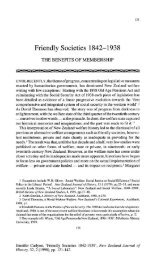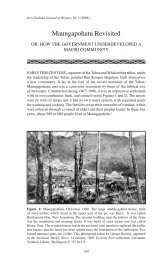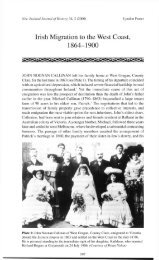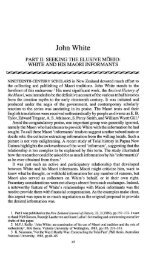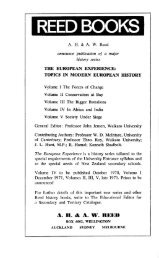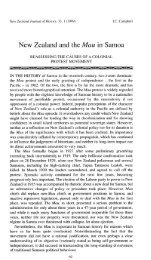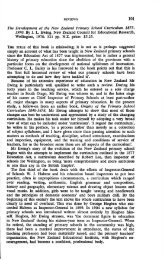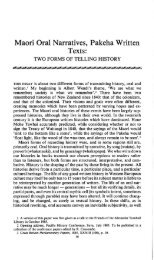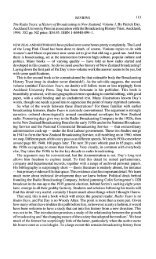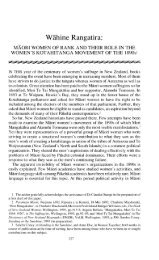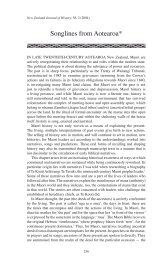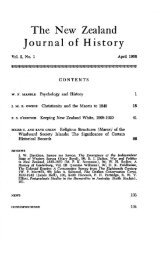Bishop G. A. Selwyn and the Melanesian Mission - New Zealand ...
Bishop G. A. Selwyn and the Melanesian Mission - New Zealand ...
Bishop G. A. Selwyn and the Melanesian Mission - New Zealand ...
Create successful ePaper yourself
Turn your PDF publications into a flip-book with our unique Google optimized e-Paper software.
BISHOP G. A. SELWYN AND THE MELANESIAN MISSION 125<br />
some months each year among <strong>the</strong> various isl<strong>and</strong> groups, opening up<br />
friendly relations with as many people as possible. These were to be<br />
persuaded to entrust to him some of <strong>the</strong>ir most promising young men<br />
who would be taken for <strong>the</strong> summer to St. John's <strong>and</strong> <strong>the</strong>re taught<br />
<strong>the</strong> English language, 'all social <strong>and</strong> civilized habits' <strong>and</strong> <strong>the</strong> basic<br />
doctrines of Christianity. At <strong>the</strong> onset of winter, when <strong>the</strong> <strong>New</strong> Zeal<strong>and</strong><br />
climate became cold <strong>and</strong> wet, <strong>the</strong> <strong>Melanesian</strong> scholars would<br />
be returned to <strong>the</strong>ir own villages where, it was hoped, <strong>the</strong>y would<br />
begin to disseminate knowledge of <strong>the</strong> new religion among <strong>the</strong>ir kinsfolk<br />
<strong>and</strong> friends. If <strong>the</strong>y proved to be intelligent <strong>and</strong> likely to benefit<br />
from fur<strong>the</strong>r instruction, <strong>the</strong>y would be taken again in <strong>the</strong> following<br />
year; if not, o<strong>the</strong>rs would be obtained in <strong>the</strong>ir place. For each scholar<br />
<strong>the</strong> process would be repeated until he was baptized <strong>and</strong> sufficiently<br />
instructed to return permanently to his home to convert his own<br />
people. The supervision, collection <strong>and</strong> return of <strong>the</strong> <strong>Melanesian</strong><br />
scholars would be supervised by <strong>the</strong> bishop himself on his 'floating<br />
<strong>Mission</strong> House', while a small b<strong>and</strong> of carefully chosen assistants<br />
would undertake <strong>the</strong> educational work at <strong>the</strong> central school. 20<br />
<strong>Selwyn</strong>'s plans for <strong>the</strong> later stages of <strong>the</strong> mission are shadowy <strong>and</strong><br />
nowhere spelt out in detail, but he appears to have envisaged <strong>the</strong><br />
fairly rapid creation of an English-speaking <strong>Melanesian</strong> Christian<br />
leadership <strong>and</strong> <strong>the</strong> emergence of a self-governing <strong>Melanesian</strong> church.<br />
The emphasis was on ecclesiastical ra<strong>the</strong>r than doctrinal independence,<br />
for he assumed that this <strong>Melanesian</strong> church would retain <strong>the</strong><br />
episcopal system of government <strong>and</strong> sufficient of <strong>the</strong> Anglican liturgy<br />
<strong>and</strong> formularies to remain in communion with <strong>the</strong> Church of Engl<strong>and</strong><br />
in <strong>New</strong> Zeal<strong>and</strong>. 21<br />
In 1849 <strong>Selwyn</strong> made his first missionary voyage, one of 3,000 miles<br />
on <strong>the</strong> 21-ton schooner Undine, during which he visited <strong>the</strong> sou<strong>the</strong>rn<br />
<strong>New</strong> Hebrides, <strong>New</strong> Caledonia <strong>and</strong> <strong>the</strong> Loyalties under <strong>the</strong> protection<br />
of Captain Erskine of H.M.S. Havannah, <strong>and</strong> returned to Auckl<strong>and</strong><br />
with five youths from <strong>New</strong> Caledonia, Lifu <strong>and</strong> Mare. The two<br />
months' voyage was significant in that <strong>the</strong> Undine was small <strong>and</strong><br />
unarmed; it was a trail-blazer only in its religious aspect, for everywhere<br />
he went <strong>Selwyn</strong> found that <strong>the</strong> s<strong>and</strong>alwooders had preceded<br />
him. Under <strong>the</strong>se circumstances he could only lament <strong>the</strong> entrenched<br />
position, superior numbers <strong>and</strong> resources of <strong>the</strong>se 'emissaries of <strong>the</strong><br />
world' as a st<strong>and</strong>ing reproach to tardy Christians. 22 Never<strong>the</strong>less,<br />
despite its late beginnings <strong>and</strong> small scale, <strong>the</strong> prospects for <strong>the</strong> new<br />
mission seemed promising enough. The Royal Navy granted its protection<br />
again in 1850 when <strong>Selwyn</strong> returned his first scholars to <strong>the</strong>ir<br />
20 <strong>Selwyn</strong>'s plans for <strong>the</strong> <strong>Melanesian</strong> <strong>Mission</strong> are expounded in his letters to<br />
E. Coleridge, 12 August <strong>and</strong> 21 December 1849, published as Two Letters irom<br />
<strong>Bishop</strong> <strong>Selwyn</strong>, Eton, 1850; also in Tucker, I, 286-94, 317-9.<br />
21 For hints see Tucker. I, 287, 292; [Anon.], The Isl<strong>and</strong> <strong>Mission</strong>, London,<br />
1869, p. 19; E. S. Armstrong, The History of <strong>the</strong> <strong>Melanesian</strong> <strong>Mission</strong>, London,<br />
1900, p. 10.<br />
22 Tucker, I, 288, 303.



